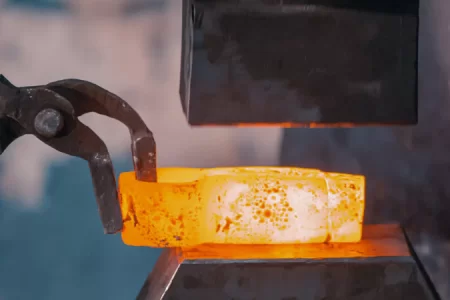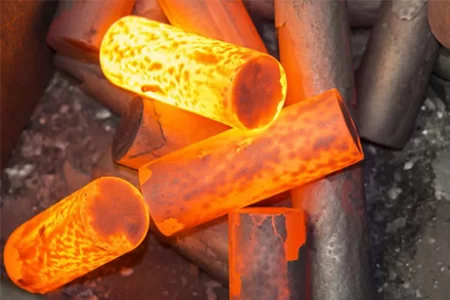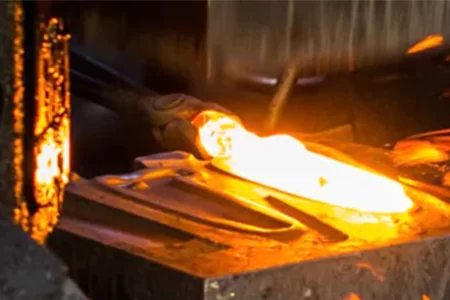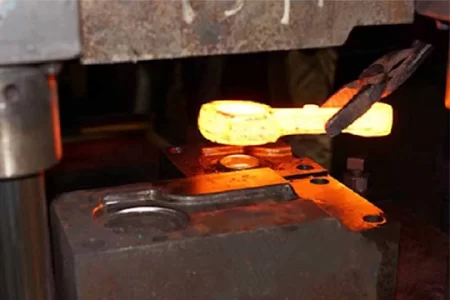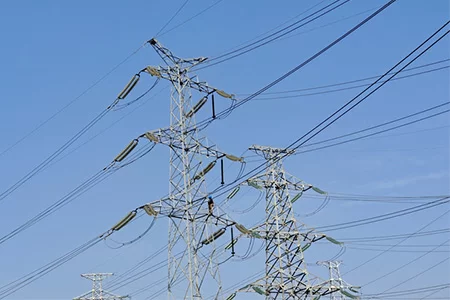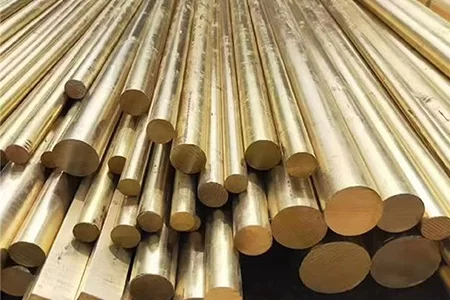By sharing knowledge, experience and views in the field of forging technology, we help you understand, learn and apply relevant technologies.

Hulk Metal Forging Technology
Share technical experience
-
Home>
-
Blog>
-
Technology>
The difference between forging and casting

In modern manufacturing, forging and casting are the two most important metal processing methods. They not only play a key role in the production process but also have irreplaceable advantages in manufacturing various parts with complex structures and high-performance requirements. Although both processes have similar goals, that is, to transform metal materials into the desired shape, there are significant differences in their processing methods, application fields, advantages, and disadvantages. This article will deeply analyze the basic definition, process flow, physical properties, advantages and disadvantages, application fields , and future trends of forging and casting to help readers understand the key differences between the two.
Basic definition of forging and casting
Forging
Forging is a manufacturing process in which metal is heated to a certain temperature by external force and pressure is applied to cause plastic deformation of the metal to form the desired shape. Depending on the processing temperature, forging can be divided into hot forging, cold forging, and isothermal forging. Hot forging is the most common method, which is suitable for plastic deformation of a metal at high temperatures, can eliminate defects inside the metal, and obtain higher mechanical properties.
The history of forging can be traced back thousands of years, and it originated from the process of humans using flames to heat metal and hammer it into shape. With the development of technology, the forging process has been greatly improved. Modern forging not only includes traditional manual forging but is also widely used in mechanized production.
Casting
Casting is a manufacturing method in which metal is heated to a molten state and then poured into a prefabricated mold for cooling and forming. The casting process can achieve the production of parts with complex shapes and is usually used for batch production and large-scale manufacturing. Common casting methods include sand casting, metal mold casting, low-pressure casting, etc. Each method has its unique advantages and applicable fields.
The casting process has a long history. Ancient humans used this technology to manufacture a large number of utensils and weapons. With the advent of the Industrial Revolution, casting technology has gradually developed into a mature manufacturing method, which is widely used in machinery, automobiles, construction, and other fields.
Comparison of forging and casting processes
Raw materials and equipment
There are significant differences in the requirements for raw materials and equipment between forging and casting. The raw materials for forging are usually metal ingots, metal bars or metal billets. After heating, these materials are plastically deformed by processes such as die forging or stamping. Forging equipment usually includes forging hammers, presses, hydraulic presses, etc., which deform metal by applying external force.
In contrast, casting uses molten metal, usually metal alloys such as copper, aluminum, iron, and steel. Casting equipment includes furnaces, pouring systems, molds, etc. The core of the casting process is how to reasonably design the mold and control the flow and cooling rate of the metal.
Comparison of process flow
The process flow of forging and casting is also very different:
Forging process flow:
Select material and heat to the appropriate temperature
Place metal on mold or workbench
Apply pressure or impact force for plastic deformation
Cool and perform subsequent heat treatment, such as annealing, quenching, etc.
Finishing to achieve final size and shape
Casting process flow:
Prepare mold (can be sand mold, metal mold, etc.)
Heat metal to molten state
Pour molten metal into the mold
Let the metal cool and solidify to obtain the preliminary shape
Remove burrs from castings and perform subsequent finishing
Surface treatment and precision
Forging can usually obtain a smoother surface, and the surface quality is higher because the metal is under pressure at high temperatures. Forgings usually have higher dimensional accuracy but still need to undergo subsequent processing to meet stricter tolerance requirements.
The surface quality of castings is usually poor, especially in the sand casting process, due to the friction between the sand mold and the metal, more surface defects such as pores and sand holes will be generated. Therefore, castings often require subsequent surface treatment, such as sandblasting and grinding, to achieve the required surface quality.
Comparison of physical and mechanical properties of forging and casting
Mechanical properties
Because the metal grains will rearrange under pressure during the forging process and the crystal structure tends to be consistent, forgings usually have higher strength, toughness, and fatigue resistance. The internal structure of forged products is dense, can withstand greater stress, and performs better at high temperatures.
The mechanical properties of casting products are greatly affected by the metal melting and cooling process. Due to the slow cooling rate of the metal during the casting process, the grains are larger and the structure is looser, so the strength and toughness of the castings are relatively low. However, with the advancement of technology, some high-precision casting methods, such as precision casting and lost wax casting, can improve the mechanical properties of castings to a certain extent.
Internal structure and grain structure
Forgings usually have a uniform internal grain structure, and the grain direction of the metal is closely related to the shape and function of the workpiece. The plastic deformation during the forging process causes the metal grains to be arranged along the direction of the force, thereby enhancing the strength and crack resistance of the parts.
Castings usually have obvious uneven grain distribution, especially large-sized castings. Due to the difference in the solidification order and cooling rate of the metal during the cooling process, defects such as pores and sand holes may appear in the internal structure of the casting. These defects will affect the mechanical properties and reliability of the casting.
Durability and service life
Forgings are usually more durable, especially for parts that bear heavy loads and high stresses, such as crankshafts of automobile engines and landing gears of aircraft. Forgings usually have a longer service life due to their dense grain structure and high strength.
The durability of castings depends on the control accuracy of the casting process and the effectiveness of its post-processing process. Although casting products can meet lower load applications in some cases, the performance of castings is usually not as stable as forgings under high load and high-temperature environments.
Comparison of advantages and disadvantages of forging and casting
Advantages and limitations of forging
Advantages:
High strength: Forgings are usually stronger and tougher than castings because the grain arrangement of the metal is more orderly.
Fewer defects: Metal deformation during forging can eliminate many internal defects, such as pores and inclusions.
High precision: Forging can achieve high dimensional accuracy and is suitable for manufacturing high-precision, high-performance parts.
Limitations:
High equipment cost: Forging requires high equipment investment, especially for the production of large forgings.
Shape restrictions: The shapes of forgings are relatively simple, and it is difficult to produce very complex geometric shapes.
Long production cycle: Compared with casting, forging has a longer production cycle and is suitable for smaller batch production.
Advantages and limitations of casting
Advantages:
Suitable for complex shapes: Casting can easily produce parts with complex shapes, especially for mass production.
Low cost: The cost of casting equipment is relatively low, and the mold-making is relatively simple, which is suitable for mass production.
Less material waste: During the casting process, the use of metal is more efficient, and the waste of materials can be better controlled.
Limitations:
Low strength: Castings usually have more defects, such as pores and sand holes, which make their mechanical properties inferior to forgings, especially under high loads and high temperatures, the durability and strength of castings are lower.
Poor surface quality: During the casting process, defects may appear on the surface of the casting due to the cooling rate and mold material, requiring additional surface treatment and increasing production costs.
Poor dimensional accuracy: Despite the advancement of modern casting technology, castings generally have lower dimensional accuracy than forgings, requiring more post-processing operations to meet strict dimensional requirements.
Why choose HULK Metal as your supplier
When choosing a supplier of forged or cast products, companies usually consider multiple factors such as product quality, production capacity, technological innovation, delivery cycle, and service level. As a leading forging and casting manufacturer, HULK Metal has become the preferred partner of many industry customers with its excellent production process, advanced technology, and customer-oriented service. Here are a few key reasons to choose HULK Metal:
High-quality forged and cast products
HULK Metal adheres to a strict quality management system, all products are ISO 9001 certified, and each product undergoes rigorous quality inspection and performance testing. Our forged and cast products have excellent mechanical properties and surface quality to meet the needs of high-load and high-strength applications. Whether it is high-end aerospace components, automotive parts, or key parts in construction and heavy machinery, HULK Metal can provide the best solution.
Advanced production equipment and technology
HULK Metal has advanced production equipment, including high-precision forging machines, precision casting equipment, and 3D printing technology. Our forging process ensures that the product has excellent strength, toughness, and durability, while our casting technology can produce parts with complex shapes and precise dimensions. By continuously introducing advanced technologies, HULK Metal is able to produce high-quality products that meet the requirements of modern industry and provide customers with flexible customized services.
Professional technical team and innovation ability
Our technical team consists of many experienced engineers and technical experts who have deep technical accumulation in forging, casting, and post-processing processes. HULK Metal also continues to invest in R&D and innovation to improve production efficiency and product quality through technological progress and process improvement. Whether it is material selection, process optimization, or product design, we can provide customers with tailor-made solutions.
Perfect after-sales service
HULK Metal is well aware of the importance of after-sales service. We provide full technical support and after-sales service. Whether you encounter problems during the use of the product or any questions after delivery, HULK Metal will provide customers with solutions with the most professional attitude and the fastest response speed. Our goal is to ensure that every customer gets the greatest satisfaction from using HULK Metal products.
Stable supply chain and efficient delivery capabilities
With many years of industry experience and strong supply chain management capabilities, HULK Metal is able to provide stable supply and on-time delivery services while ensuring high quality. Our production plans and delivery cycles are carefully arranged to ensure that customers can get the required products on time, especially in terms of emergency orders and mass production needs, we can provide flexible and efficient responses.
Environmental protection and sustainable development
Today, when environmental protection is becoming a global focus, HULK Metal has been committed to promoting green production. We use energy-saving and environmentally friendly production processes, actively optimize the production process, and reduce energy consumption and waste emissions. At the same time, we are constantly improving the recyclability of our products in response to global environmental protection trends. Choosing HULK Metal will not only get high-quality products but also help us with sustainable development.
Flexible Customized Services
The needs of each industry are different. HULK Metal provides flexible customized services to adjust the design and process according to the specific requirements of customers. Whether it is small batch customization or large-scale production, HULK Metal is able to provide high-quality products and the most optimized solutions to meet the different needs of customers.
As an industry-leading forging and casting solution provider, HULK Metal has won the trust of global customers with its excellent product quality, advanced technology, professional team, and perfect after-sales service. If you are looking for a forging or casting partner that can provide high performance, customization, environmental protection, and high efficiency, HULK Metal is undoubtedly your ideal choice. By cooperating with HULK Metal, you will be able to obtain top product quality, technical support, and a full range of services to ensure that your project goes smoothly and successfully.
In the future manufacturing industry, enterprises should scientifically select appropriate process methods based on factors such as product performance requirements, shape complexity,y, and production scale to enhance the market competitiveness of products.
Article Navigation
Article Navigation
Industries
Foundries
-

July.01, 2024
Difference between hot forging and cold forging
READ MORE
-

June.27, 2024
What are the advantages and disadvantages of the hot forging process?
READ MORE
-

January.18, 2024
Forging: What Is It? What Are The Different Types of Hot Forging?
READ MORE
-

November.29, 2024
What is steel forging?
READ MORE
-

November.08, 2024
How to produce high-quality wire pulling grips?
READ MORE
-

July.30, 2024
What are the materials for hot forging?
READ MORE



